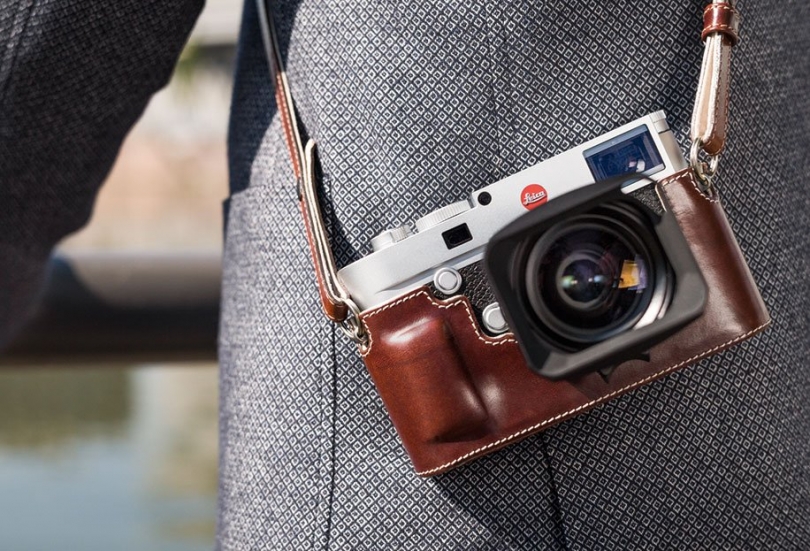
Hands-on with new Leica M10 The new Leica M10 is slightly slimmer than its predecessor, a bit lighter, faster and (we think) a little more sensible. This 24MP full-frame rangefinder can't shoot video and there's not a even a USB jack, but for all that it's surprisingly modern, thanks to built-in Wi-Fi and a very usable live view implementation, among other things.
We've had access to a pre-production camera for a few days - click through for a quick tour.
Hands-on with new Leica M10
From the front, the Leica M10 looks a lot like the Typ 240 and Typ 262 that came before it. Unlike earlier M-series cameras though it lacks a frame-line illumination window. The frame-lines are illuminated with an internal LED. The small black lever allows you to preview the (approximate) frame coverage of other focal lengths, when you have a lens mounted.
Hands-on with new Leica M10
The 24MP CMOS sensor in the M10 is 'newly developed', but we don't know exactly what this means. Although we haven't yet completed our full range of studio tests (we'll have to wait for a final shipping camera before we do that) our initial impressions of image quality are extremely positive. Detail resolution is high across the M10's standard ISO range of 100-6400, and noise is well-controlled even at high ISO sensitivity settings.
The M10 also incorporates an upgraded processor, the 'Maestro II' (first seen on the Leica SL), along with 2GB of buffer memory. This allows the camera to shoot at up to 5 fps for 30 Raw files (~100 JPEGs).
Hands-on with new Leica M10
Physically, the M10 is slimmer than previous M-series digital cameras, and very slightly lighter. It's slightly taller than the film-era M6 (and previous models) but has basically the same footprint. Although the size reduction is relatively subtle, the M10 definitely feels like a more compact camera than the Typ 240.
Hands-on with new Leica M10
New in the M10 is a physical button for ISO adjustment, which occupies previously wasted space on the upper left of the digital M-series. ISO can be adjusted in full stops from 100-6400, plus a user-assignable 'M' setting. A very practical Auto ISO setting is also available, which offers automatic maximum shutter duration options based on focal length (with 6-bit coded lenses) as well as user-assignable settings.
Hands-on with new Leica M10
The M10's on/off switch is simpler than it was in previous digital M-series cameras, and no longer provides access to continuous and self-timer shooting modes. Whether this is a good thing depends on how much you use continuous and self-timer, but on balance we prefer it. These modes are now accessed via the M10's menu system.
Hands-on with new Leica M10
Speaking of which, the M10's menu system has been simplified, and now includes a customizable 'favorites' menu, which appears by default on the first press of the 'menu' button. The full menu appears on the second press. The M10's 3" rear screen is coated in Corning 'Gorilla Glass' for scratch resistance and offers a resolution of 1. 04 million dots.
Hands-on with new Leica M10
An optional ($545) 'Visoflex' electronic viewfinder can be attached to the M10 for live view shooting. This isn't as silly as it sounds - shooting in live view ensures accurate framing, and accurate critical focus, and also allows you to use spot and 'multi-field' metering. The Visoflex Typ 020 offers a resolution of ~2. 4MP and includes a GPS module.
Hands-on with new Leica M10
The Visoflex can tilt up to 90 degrees, which is handy for close-up work and candid photography.
Hands-on with new Leica M10
Some things will never change though, and one of those things is Leica's insistence on retaining the film-era removable baseplate. This made sense (sort of) a few decades ago, but does seem increasingly silly in the digital age. Supposedly it helps keep the camera dust and water-resistant (to some extent at least - Leica doesn't say exactly how much) but removing the bottom of the camera to change a memory card is a bit of a pain - especially if you're working on a tripod.
The slimmer body has necessitated a smaller battery, which offers a capacity of 8. 2Wh, which carries a CIPA rating of ~210 shots - increasing to ~500 if the camera is used in rangefinder mode (i. e, not live view). This isn't particularly impressive, but as usual, in normal use (with Wi-Fi turned off) we've found that a single charge can be expected to last for much longer, assuming minimal 'chimping'.
Hands-on with new Leica M10
This view gives you a good idea of the M10's generally uncluttered control layout, which will look familiar to anyone who has ever used an M-series camera at any point in the last 60 years.
The Leica M10 is available now, for a body-only price of $6595. What do you think?
. dpreview.com2017-1-19 23:00





